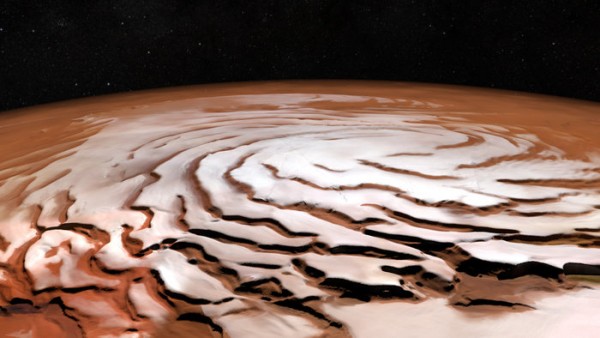By Ana Verayo, | February 05, 2017

Perspective view of the Mars north polar ice cap and its distinctive dark troughs forming a spiral-like pattern. (ESA/DLR/FU Berlin; NASA MGS MOLA Science Team)
New images have revealed the frozen North Pole region of Mars. The images were taken by the European Space Agency's Mars Express orbiter which is currently observing the Red Planet. In this particular photo, this region seems like a cosmic pastry dessert with icy swirling spirals.
Like Us on Facebook
This new image was obtained during the ESA's Mars Express observations between 2004 to 2010, which included a total of 32 flybys and a coverage of one million square kilometers across the surface of the dry, alien world. This new mosaic also highlights the swirling perfection of this ice cap found on the North Pole of Mars, which is created by climate cycles and shaped by Martian winds.
With the help of data obtained from the Mars Orbiter Laser Altimeter (MOLA) which is onboard NASA's Mars Global Surveyor spacecraft, ESA scientists were able to create a perspective of this ice cap, which is enhanced with deep canyons. This means that scientists were able to create a view that can be seen by someone who is flying over this Martian North Pole.
In addition to these stunning images, ESA's Mars Express mission studied the Martian North Pole and obtained crucial evidence about the geological forces that continue to shape this frozen region.
Apparently, this ice cap is a natural carbon sink during winter on the Red Planet, where 30 percent of the carbon dioxide found in the atmosphere can freeze out, becoming dry ice that can reach up to a meter thick.
When spring and summer season on Mars arrives, this carbon dioxide dry ice layer can sublimate, turning solid ice into gas which gets absorbed again by its atmosphere. All that is left behind are permanent liquid water layers.
Recent studies indicate that there are also multiple layers of ice and dust on this region, which serves as evidence of changes in Martian climate, at least 10,000 years ago, also revealing how Mars is tilting.
Scientists suggest that the ice cap's swirling spiral shape was formed by the unique movement of surface winds on the planet called the Coriolis force.
-
Use of Coronavirus Pandemic Drones Raises Privacy Concerns: Drones Spread Fear, Local Officials Say

-
Coronavirus Hampers The Delivery Of Lockheed Martin F-35 Stealth Fighters For 2020

-
Instagram Speeds Up Plans to Add Account Memorialization Feature Due to COVID-19 Deaths

-
NASA: Perseverance Plans to Bring 'Mars Rock' to Earth in 2031

-
600 Dead And 3,000 In The Hospital as Iranians Believed Drinking High-Concentrations of Alcohol Can Cure The Coronavirus

-
600 Dead And 3,000 In The Hospital as Iranians Believed Drinking High-Concentrations of Alcohol Can Cure The Coronavirus

-
COVID-19: Doctors, Nurses Use Virtual Reality to Learn New Skills in Treating Coronavirus Patients







